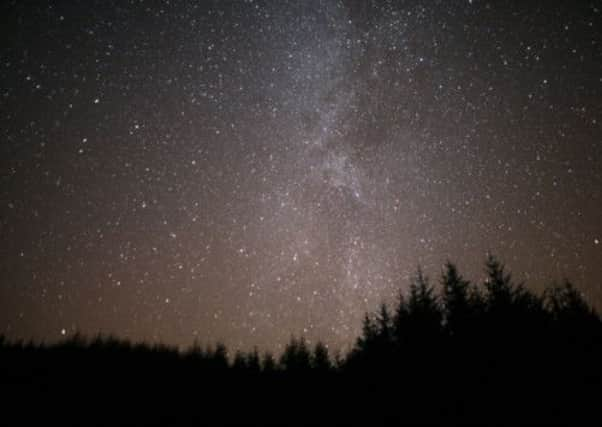Book review: The End Of Night by Paul Bogard


The End of Night
Paul Bogard
Fourth Estate, 324 pp, £16.99
In Hesiod’s Theogony, we get a glimpse of the Ancient Greek attitude to the heavens: “From Chaos came forth Darkness and black Night; but of Night were born Aether and Day, whom she conceived and bare from union in love with Darkness. And Earth first bare starry Heaven, equal to herself, to cover her on every side, and to be an ever-sure abiding-place for the blessed gods.”
As Paul Bogard shows in this interesting book, subtitled Searching for Natural Darkness in an Age of Artificial Light, that “ever-sure” is under threat. It is not just the 24/7 neon glow of Las Vegas that is encroaching on our appreciation of the night sky: it is every all-night supermarket and petrol station, every motion-sensitive outside light, every new road-development, marked by unnecessary street lights.
Advertisement
Hide AdIt is notable that for Hesiod, darkness and night were not synonymous. This was impressed on me when we moved from Edinburgh to the Scottish Borders. At first, it seemed only sensible to take a torch for the mile-and-a-half walk home from the bus. The more I walked the twisting road, the more I realised how unnecessary the torch was. Between the two halves of the village, even with just a new or waning moon, the stars themselves lit up the landscape. On very clear nights, the sky is stippled with light. Twinkle has a real meaning. If I walk up the hill behind the cottage, looking to the north, the stars are consumed by the orange bleed of Edinburgh’s sodium nimbus. It is the colour of cheap processed cheese.
But it’s too easy to blame the big city for eroding the night sky. Even in the village, the primary school has over a dozen glaring lights. That it has not been burgled, ransacked and covered with graffiti might be due to the efficacy of these unblinking sentinels. Or it might be because there are very few committed hooligans in a small rural village, and the Council’s insurers demand such lighting despite any need. In fact, if there are any hooligans, it might be myself and my neighbour H – for legal reasons, an initial must suffice – who have often pondered taking a catapult or a pellet-gun to the lights, as this rural school is floodlit as if it were part of Guantanamo Bay.
Bogard structures his book, cutely, around the Bortle Scale, an imprecise but useful measure of light pollution ranging from the 9 of the inner city to the 1 of true darkness. He journeys to locations that exemplify each point of the scale, from the Luxor Beam in Vegas (equivalent to forty billion candles) to the island of Sark and from Flagstaff, Arizona (a pioneer in curbing artificial lighting) to the Sahara Desert. Along the way, in this now typical form of non-fiction, we get bits of autobiography, interviews with activists, pieces of history, science and folklore, apposite quotation and quirky aside. Bogard writes as if he intends to be the Neil Oliver or Brian Cox of light pollution; a sometimes aggravating present-tense voice-over quality infects the prose.
It also means that certain aspects shade from reportage to stated fact. People who work night-shifts and are exposed to much more artificial light can display higher incidences of cancer. But correlation is not causation, and despite the caution of the scientists, the book insists on the link (many other natural darkness activists cite the same statistic turned diagnosis). Night shift workers are also poorer, and often not white in the USA, but that doesn’t mean that being black or poor causes cancer.
Bogard is on securer ground when he discusses the ecological catastrophe of artificial light, from interference with migratory patterns, to altered feeding circumstances (check out the time-lapse picture of insects around the Luxor Beam), to the decline of moth populations. To his credit, Bogard raises the idea that Christianity insists on a light/dark dichotomy only to dismiss it: in the Bible, darkness is when the Lord tends to speak, even though he speaks light into being. Sometimes the tendency to quote experts can be gauche: “Historian E. Roger Ekirch reports that ‘pre-modern observers spoke sarcastically of candles that made darkness visible.’” Historian E Roger Ekirch and Paul Bogard ought to realise that “darkness visible” is a quote from Paradise Lost, which has nothing whatsoever to do with candlelight and is not sarcastic in the original, but terrifying.
Like other writers in the field (Caspar Henderson, Sara Maitland, Kathleen Jamie, Robert Macfarlane) Bogard is sensitive to the linguistic poverty our alienation from the natural world causes. Most children I can know can name all the Avengers, or list the members of their favourite bands, but can’t tell an oak from a birch, a hare from a rabbit, or pick out the Pleiades in the sky. There is a moral imperative behind such knowledge. It makes the world more finely-grained, and knowing that a “bird” can be a nuthatch or a rook or a heron might make it more likely that someone can realise that a “Muslim” or “homosexual” or “Unionist” might be equally diverse categories. Bogard is at his best when he describes how wonder can make us more empathetic: the fact that the biggest thing we will see in our life is a star light-years away ought to create a sense of humility.
The End Of Night is a book I will probably cite and refer to rather than re-read. But it should be read, and its ardour is impressive even if its style is sometimes awry.